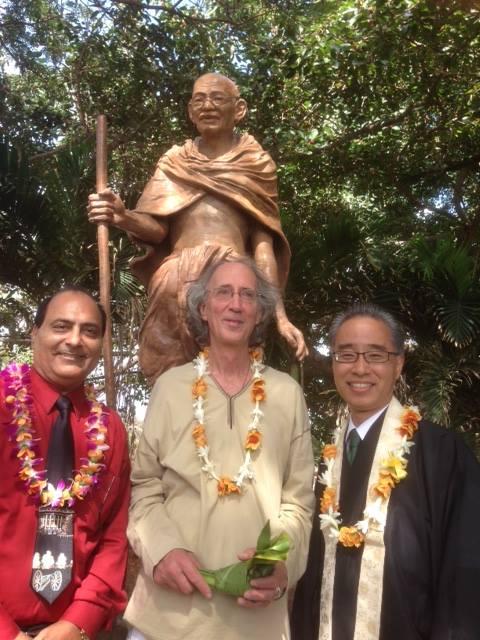
The journey of the Gandhi statue in Waikiki begins with the sculptor, Stephen Lowe’s integral ties to Nepal where he learned the traditional art of metal casting. As the son of a career army officer, Stephen travelled throughout Asia and eventually immersed himself in the culture of Nepal for 22 years beginning in the early 1980’s. Stephen studied with woodcarving and bronze casting masters in Nepal and set up two woodcarving workshops in Bhaktapur, a city near Kathmandu to preserve traditional artistic styles and help maintain their relevance in today’s world.
While Stephen was busy setting up two woman-run paper factories, jewelry workshops and a craft materials export business in Nepal, he travelled back and forth to his Staten Island, New York studio. There he worked with his close friend and talented Bulgarian sculptor Zlatko Paunov on several art projects, including making statues of Gandhi. One of which was placed in San Francisco at the Ferry Building and the other one on Waikiki Beach in Honolulu.
Lowe stated that the Gandhi statues were made based on a couple of vintage photographs but mostly from creative license and feelings about Gandhi. Stephen describes the process “First a life-sized clay model was first made, then a plaster mold. A wax model was then made, which allowed further modeling details. A final mold was made and given to an area foundry for casting in metal. The chasing and patina were the final touches. Originally, there was a girl child figure made as well, although never attached nor included for public display.”
As an artist and Native American, (Stephen is a member of the Shawnee Tribe), Stephen has a distinct outlook on the creative process and explains “Creative expression is often one of meditation–or mindfulness, in that the artist may ideally identify with the subject on a consciousness level however removed in time or space. Talent, skill and vision are all subservient to spiritual awareness when one allows oneself to be aware of it. Spiritual awareness can express itself or exist as a reality, as a brief moment of enlightenment or as a way of living/viewing ones life.”
Stephen has a perspective on art that includes the importance of giving back to the community and culture. For example, the businesses that Stephen set up in Nepal were donated to those artist’s and families that he worked with and to this day, many people have been employed and learned skills in traditional arts through these companies. With the Gandhi statues, their creation was a donation on the artist’s behalf no money was taken to make them other than for materials. Stephen explains “I had always distanced myself from a commission of this type solely based of monetary compensation. The artists were simply at the right place and time–open to help visualize a historical figure sans politics, glory, or personal gain.”
As part of being at the “right place and time” Stephen presented small busts of Gandhi to President Ronald Reagan and President Mikhail Gorbachev for their efforts in ending the Cold War. The Gandhi statue in Waikiki honors his basic values of humanitarian assistance and message of positive social change through non-violent means. “We all need to find truth in our life to help our outlook and guide our actions towards mankind, the earth, its many creatures and the spirits dwelling everywhere. That’s life’s challenge and wonder.” The Gandhi statues are signposts for us to find our inner strength, resolve and faith that people can change the world through non-violence. Only love can conquer hate.
